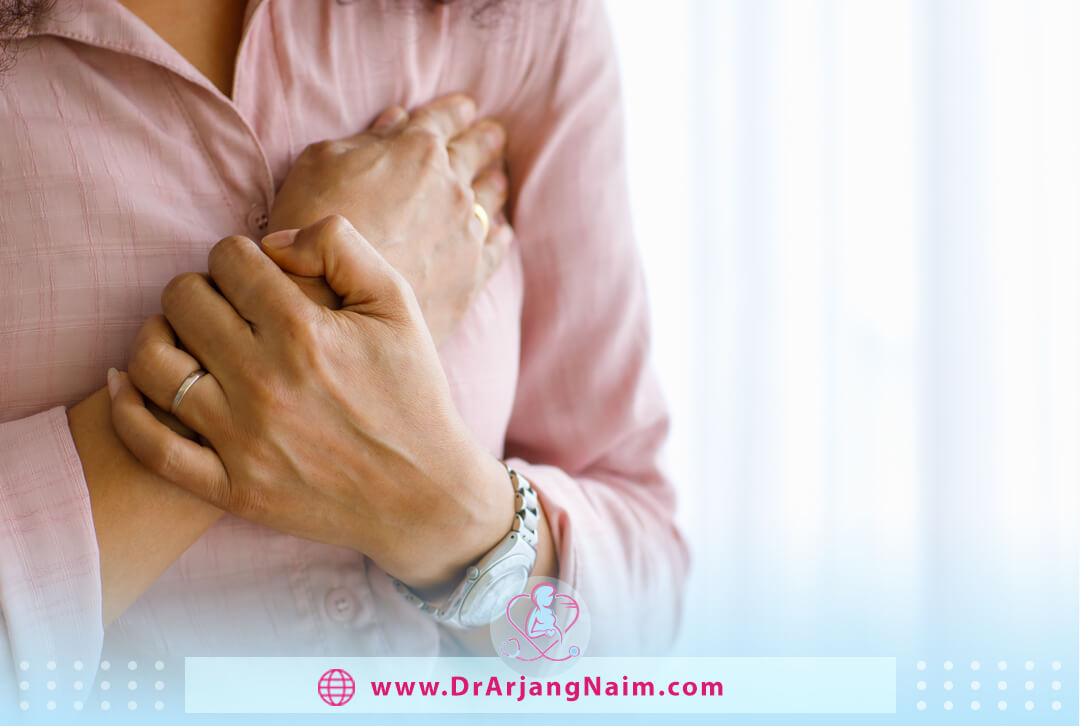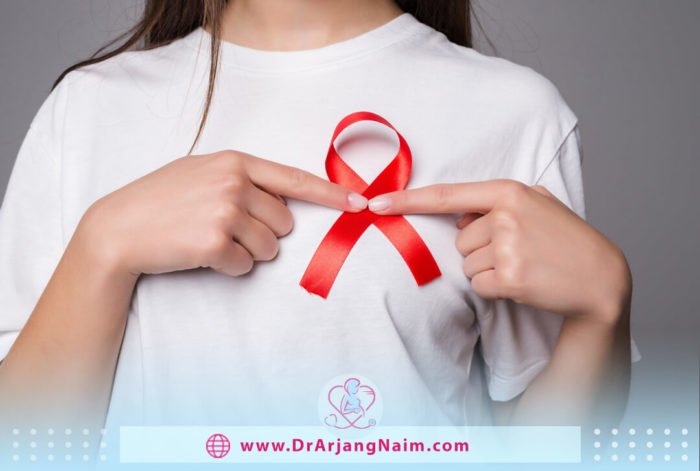Breast cancer is cancer that develops in the breast cells. This type of cancer is the most common invasive cancer in women and the second leading cause of cancer death in women after lung cancer.
It can occur in both men and women but is much more common in women. Cancer occurs when changes called mutations in genes that regulate cell growth occur. Mutations allow cells to divide and multiply uncontrollably.
Typically, cancer develops in the lobules or ducts of the breast. The lobules are the milk-producing glands and are the ducts that carry milk from the glands to the nipple. Cancer can also develop in adipose tissue or fibrous connective tissue inside the breast. Uncontrolled cancer cells often invade other healthy breast tissue and travel to the lymph nodes under the arms. Lymph nodes are a primary pathway that helps cancer cells travel to other parts of the body.
Symptoms

The first signs of breast cancer usually appear as an area of thick tissue in the breast or a lump in the breast or armpit. Other symptoms include:
- Pain in the armpits or breast that does not change with the menstrual cycle
- Pitting or redness of the skin of the breast
- A rash around or on one of the nipples
- Discharge from a nipple, possibly containing blood
- A change in the size or shape of the breast
- Peeling, flaking, or scaling of the skin on the breast or nipple
- A sunken or inverted nipple
Most breast lumps are not cancerous. However, women should see a doctor if they notice a lump on the breast.
Types of breast cancer
There are different types of breast cancer.
Angiosarcoma
Angiosarcoma is a rare cancer that develops in the lymph vessels and walls of blood vessels. Lymphatic vessels are the part of the immune system that collects and excretes bacteria, viruses, and waste products from the body.
Angiosarcoma can occur anywhere on the body but most often occurs on the scalp and neck. Rarely it may occur on the skin of other parts of the body, such as the breasts. It may occur in deeper tissues such as the liver and heart. Angiosarcoma can occur in areas that have previously been treated with radiation therapy. Treatment for angiosarcoma depends on the location of cancer. Treatment options may include surgery, radiation therapy, and chemotherapy.
Ductal carcinoma in situ (DCIS)
In situ ductal carcinoma (DCIS) is the presence of abnormal cells inside the milk duct in the breast. CIS is the first form of breast cancer. DCIS is non-invasive, meaning it does not spread through the valve and has a low risk of invasion. It is usually found during a mammogram as part of a breast cancer screening or to check for a breast mass. While DCIS is not an emergency, it needs to evaluate and consider treatment options. Treatment may include radiation-protected breast surgery or surgery to remove all breast tissue.
Inflammatory
It is a rare type of cancer that progresses rapidly and makes the affected breast red, swollen and tender. Inflammatory breast cancer occurs when cancer cells block the skin’s lymphatic vessels, causing the breast to become swollen and red.
Inflammatory cancer is considered a locally advanced cancer, meaning that it spreads from the point of origin to nearby tissue and possibly to nearby lymph nodes. This type of cancer can be easily confused with a breast infection, a very common cause of redness and swelling of the breast.
Invasive lobular carcinoma
Invasive lobular cancer is a type of cancer that starts in the breast’s milk-producing glands (lobules). It means that the cancer cells have left the lobule where they started and have the potential to spread to the lymph nodes and other areas of the body. Invasive lobular carcinoma is a small part of all breast cancers.
Lobular carcinoma in situ (LCIS)
Lobular carcinoma in situ (LCIS) is an uncommon disease in which abnormal cells form in the breast’s mammary glands (lobules). LCIS is not a cancer, but a diagnosis of LCIS indicates that a person is more likely to develop breast cancer. CIS is not usually seen on mammograms. The disease is often the result of a breast biopsy performed for other reasons, such as a suspected breast mass or an abnormal mammogram. Women with LCIS are more likely to develop invasive cancer in both breasts.
Male
Men’s breast cancer is rare cancer that occurs in men’s breast tissue. Although it is more likely to be a disease that affects women, it also occurs in men. Men who are diagnosed with early breast cancer have a good chance of being treated. Treatment usually involves surgery to remove the breast tissue. Other treatments such as chemotherapy and radiation may be recommended depending on the situation.
Paget’s disease of the breast
Paget’s disease of the breast (PAJ-it) is a rare type of breast cancer. It begins in the nipple and spreads to the dark circle of skin around the nipple.
Recurrent
Recurrent breast cancer is a cancer that comes back after initial treatment. Although initial treatment kills all the cancer cells, some of them may escape treatment and survive. These undetected cancer cells multiply and become recurrent cancer.
It may develop months or years after initial treatment. Cancer may return to the original site of cancer (local recurrence) or spread to other parts of the body (remote recurrence).
Risk factors
The exact cause of breast cancer is still unknown, but some factors increase the risk.
Age
The risk of breast cancer increases with age. At age 20, the risk of cancer is 0.06. At age 70, that number rises to 3.84.
Genetics
Women with mutations in the BRCA1 and BRCA2 genes are more likely to develop breast cancer, ovarian cancer, or both. People inherit these genes from their parents. Mutations in the TP53 gene have also been linked to an increased risk of it. If a close relative has breast cancer, a person is more likely to get it. It is recommended that people in the following groups have a genetic test:
- People with a family history of breast, ovarian, fallopian tube, or peritoneal cancer
- Those who have a family history of breast cancer related to BRCA1 or BRCA2 gene mutations
History
Women who have had breast cancer before are more likely to get it again than those who do not. Having some non-cancerous breast masses increases the risk of developing cancer later in life. Examples include atypical duct hyperplasia or lobular carcinoma in situ.
Dense breast tissue
Women with dense breasts are more likely to diagnosis breast cancer.
Estrogen exposure and breastfeeding
Breastfeeding for more than a year seems to reduce the risk of breast cancer. Prolonged exposure to estrogen increases the risk of breast cancer. This could be because the person is menstruating earlier or entering menopause at a later than average age. Between these times, estrogen levels are higher. Breastfeeding, especially for more than a year, reduces the risk of breast cancer. This is probably due to reduced estrogen exposure after pregnancy and lactation.
Bodyweight
Women who become overweight or obese after menopause are more likely to develop breast cancer due to increased estrogen levels.
Alcohol consumption
Regular alcohol consumption plays a role in causing breast cancer. Women who drink alcohol are more likely to develop cancer than those who do not. People who drink moderately to heavily are more at risk than those who drink lightly.
Radiation exposure
Radiation therapy for various cancers may increase the risk of breast cancer later in life.
Diagnosis
The doctor will often diagnose breast cancer as a result of routine screening or when a woman sees a doctor after she has symptoms. Several tests and diagnostic methods help confirm the diagnosis.
Breast exam
The doctor will examine breasts for lumps and other symptoms.
Imaging tests
Several tests can help with the diagnosis.
Mammogram

It is a type of X-ray that doctors usually use during the initial cancer screening. Produces images that can help doctor diagnose any lumps or abnormalities.
Ultrasound
The scan uses sound waves to help the doctor distinguish between a solid mass and a fluid-filled cyst.
MRI
Magnetic resonance imaging (MRI) combines different breast images to help your doctor diagnose cancer or other abnormalities. Your doctor may recommend an MRI as a mammogram or ultrasound. Doctors sometimes use them as screening tools for people who are more prone to cancer.
Prevention
Making changes in daily life may help reduce the risk of cancer. Talk to your doctor about starting breast cancer screening tests, such as clinical tests and mammograms.
Consult doctor immediately if you have new changes, bumps, or other unusual symptoms in your chest. Awareness of the breast cannot prevent cancer, but it may help to understand the natural changes of the breasts better and identify unusual signs and symptoms.
Alcohol consumption should be in moderation. If you drink alcohol, do not drink more than once a day. Try to exercise most days of the week.
Limit postmenopausal hormone therapy. Combination hormone therapy may increase the risk of breast cancer. Some women experience annoying signs and symptoms during menopause, and for these women, an increased risk of breast cancer is acceptable to relieve the signs and symptoms of menopause. To reduce the risk of breast cancer, use the lowest possible dose of hormone therapy in the shortest possible time.
Having a healthy diet and an ideal weight can help prevent it. Women on a Mediterranean diet mixed with extra virgin olive oil and nuts may have a lower risk of breast cancer. The Mediterranean diet focuses on plant foods such as fruits and vegetables, whole grains, legumes, and nuts. People who follow the Mediterranean diet choose healthy fats such as olive oil instead of butter and fish instead of red meat.
Treatment
Treatment depends on several factors, including:
- The type and stage of the cancer
- The person’s sensitivity to hormones
- The age, overall health, and preferences of the individual
The main treatment options are:
- Surgery
- Biological therapy, or targeted drug therapy
- Hormone therapy
- Chemotherapy
Surgery
Types of surgery include:
- Lumpectomy: Lobectomy can prevent the spread of cancer. If the tumor is small and easily detached from the surrounding tissue, this option is possible.
- Mastectomy: A simple mastectomy involves removing the lobules, ducts, adipose tissue, nipple, areola, and some skin. In some cases, the surgeon also removes the lymph nodes and muscles of the chest wall.
- Sentinel node biopsy: If cancer reaches the sentinel lymph nodes, which are the first nodes to which cancer can be transmitted; it can spread to other parts of the body through the lymphatic system. If the doctor does not find cancer in the guard nodes, removing the remaining nodes is usually no need.
- Axillary lymph node dissection: If the doctor finds cancer cells in the guard glands, they may recommend removing several axillary lymph nodes. This can prevent cancer from spreading.
- Reconstruction: After a mastectomy, the surgeon can reshape the breast to make it look more natural. This can help a person cope with the psychological effects of breast removal.
Radiation therapy
The doctor may recommend that the patient have radiation therapy for about a month after surgery. Targeting the tumor with controlled doses of radiation kills the remaining cancer cells.
Chemotherapy

If the risk of recurrence or spread is high, the doctor may prescribe cytotoxic chemotherapy drugs to kill the cancer cells. When a person undergoes chemotherapy after surgery, doctors call it adjuvant chemotherapy. Sometimes, the doctor may choose chemotherapy before surgery to shrink the tumor. Doctors call this neoadjuvant chemotherapy.
Hormone blocking therapy
Doctors use hormone-blocking therapy to prevent the return of hormone-sensitive breast cancers after treatment. Hormone therapy may be used to treat estrogen receptor (ER) and progesterone receptor (PR) positive cancers. They usually do the hormone-blocking therapy after surgery, but sometimes they may use it to shrink the tumor.
Hormone blocking therapy may be the only option for not good candidates for surgery, chemotherapy, or radiation therapy. Doctors may recommend that a person undergo hormone therapy for 5 to 10 years after surgery.
Targeted drugs can kill certain types of breast cancer. Examples are:
- Trastuzumab (Herceptin)
- Lapatinib (Tykerb)
- Bevacizumab (Avastin)
Treatment for breast cancer and other cancers can have serious side effects. When deciding on treatment, the patient should discuss the potential risks with the doctor and consider minimizing side effects.
Survival rate
The survival rate of breast cancer varies based on many factors. At the time of diagnosis, two important factors are the type of cancer and the stage of cancer. Other factors that may play a role are gender, age, and race.
The good news is that survival is improving. The five-year survival rate for breast cancer varies depending on the stage of diagnosis, ranging from 99% for local cancers in the early stages to 27% for advanced metastatic cancers.
The bottom line
Breast cancer is the presence of malignant cells that affect the breast tissue or mammary glands. This type of cancer is not specific to women but may also affect men. But the disease is more common among women. Treatment for it depends on a number of factors, including the size and location of the breast mass, the extent of the disease, the patient’s age, the patient’s general health, and the frequency. It is usually treated with several methods, which are selected depending on the patient’s physical condition and the type of cancer.
Arjang Naim, MD, and his team will adopt the best treatment method after a thorough examination of a person suspected of breast cancer.
Additional questions
- How quickly does breast cancer spread?
On average, breast cancer doubles in size every 180 days, or every 6 months. However, the growth rate for any particular cancer depends on many factors.
- Does breast cancer cause obesity?
Approximately 80 percent of people diagnosed with breast cancer experience weight gain.
- Is breast cancer more common in the left breast?
Breast cancer occurs more often in the left breast than the right. The left breast is 5 to 10% more prone to cancer than the right breast.
- What is the last stage of cancer patients?
Patients may have difficulty swallowing food and liquids at the end of life. Both liquids and food may be difficult to swallow, causing weight loss, loss of appetite, muscle wasting, and weakness.
- What does breast lobule feel like?
It is most often found in women in their 40s, but it can occur at any age. They are often like round lumps that are mobile and may also be felt to the touch.
References:
https://www.mayoclinic.org/diseases-conditions/male-breast-cancer/symptoms-causes/syc-20374740
https://www.mayoclinic.org/diseases-conditions/angiosarcoma/symptoms-causes/syc-20350244
https://www.mayoclinic.org/diseases-conditions/breast-cancer/diagnosis-treatment/drc-20352475
https://www.medicalnewstoday.com/articles/37136#outlook
https://www.healthline.com/health/breast-cancer




